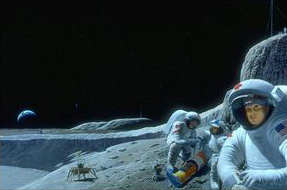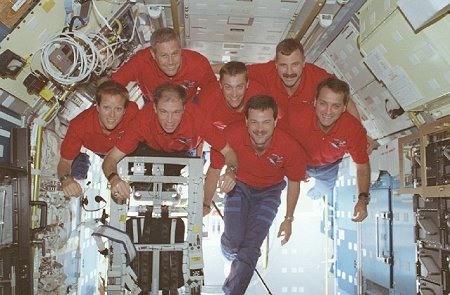|
To an astronaut far from home, it's as important as oxygen,
fuel and radiation shielding: team work.
by Karen Miller
Weakened bones, radiation-damaged
cells, spacecraft malfunctions - when you think of journeying through
space, these are the threats that come to mind. Yet, there's another
issue equally critical.
That issue is teamwork.
Astronauts don't travel
through space by themselves. They go in pairs or threesomes or even
larger groups. Maintaining a successful team in a risky, isolated
environment calls for finely honed people-skills. It means
that astronauts must develop a keen awareness both of themselves,
and of the way they interact with those around them.
Of course, astronauts
are already people-savvy. They wouldn't be selected as astronauts
otherwise. But NASA would like to give them an extra edge, an extra
dose of training to help them "team up" exquisitely well.

Art by Pat Rawlings. More
Three
astronauts on the Moon, one with a broken leg.
|
James Carter, a psychologist
at Harvard Medical School and Beth Israel Deaconess Medical
Center, and Jay Buckey, a doctor and associate professor of medicine
at Dartmouth, are heading a NASA project to do just that. They're
developing a teamwork training program that can be delivered entirely
through a laptop computer - here on the ground or in the distant
reaches of space.
"If you have
a group of people who are very smart about how to work together
as a team, that's a group that's going to do well no matter how
bad things get," says Buckey, himself an astronaut. "If
we can provide the kind of training that gives astronauts that
'extra edge,' then we're opening the door to effective space flight."
Their program includes
an interactive simulator set onboard a virtual space station akin
to the International Space Station (ISS). It allows an astronaut
to role-play interpersonal conflicts on the computer. For example,
the simulator might present this situation: one crewmember (represented
by an actor) accidentally damages a piece of equipment, and asks
a crewmate (the role assumed by the astronaut working through
the program) for help in concealing the damage. The astronaut
decides how to answer the request, and then the program responds,
based on that answer.

More
A
space shuttle crew of seven in 1998. Jay Buckey floats
at the top left.
|
Does any conflict ensue?
Will it escalate?
"It's a web of
options," explains Carter. "You watch a video and then
you make a decision. Your choice determines what happens next. You
can get through the conflict in as few as three or four decisions,
or you can make 10, 15, or even more decisions."
There are about 65
video "decision points," with different decisions leading
to different resolutions - "from the worst case to the best
case scenarios, and everything in between," notes Carter. Astronauts
are encouraged to go through the scenarios and experiment with different
choices to see how each choice affects the outcome.
The program, which
is still under development, has not yet been tested to see whether
it really does reduce conflict and build stronger teams. Some observers
are skeptical that interacting with a computer can teach humans
to interact more successfully with other human beings. "We're
definitely pushing the envelope," admits Buckey.
However, points out
Carter, computers have been used successfully to handle some similar
problems. They've been used, for example, to treat panic disorders.
And other work also augurs the program's success:
Research has shown
that computers may in some ways exceed the performance of human
therapy-providers. "Studies done over the past 30 to 40 years
have established," says Carter, "that people are more
likely to reveal sensitive information to a computer than to an
interviewer."

More
Cosmonaut
Yury Usachev works at a laptop computer in his crew compartment
onboard the International Space Station
|
He speculates that
some people are simply more comfortable with computers. "They
may expect to be judged if they report problems to a human. But
a computer doesn't judge."
On long-duration space
missions, astronauts could run the program in total privacy, however
they like, whenever they feel the need. Ease of use and privacy
are keys: Often, people are reluctant to ask for help because they
don't want to publicize the fact that they need it. They don't
attempt to deal with a situation until it has escalated. With a
program that's both convenient and private, users will be more likely
to get help while problems are still at a less critical - and far
more resolvable - stage.
Carter and Buckey
are continuing to add to the program. In addition to developing
more conflict scenarios, they plan to develop an algorithm for treating
depression. Other types of content are also possible, such as cultural
cross-training - useful for international crews - and stress management.
"It’s not
that there are a lot of these problems occurring," says
Carter. Astronauts are well-balanced people with superb skills at
handling conflict and managing stress. "Our program is really
just to fortify the crew, to give them extra training and make them
even more effective as a cohesive unit."
According to NASA's
new Vision
for Space Exploration, astronauts will be going back to the
Moon and beyond to Mars. They'll be spending more time farther from
Earth than ever before. Extra training is a good thing.
Buckey agrees. "Astronauts
are professionals, but they're going to be in a tough environment.
We're trying to make sure that they're able to deal with that environment
in the best way possible."
|
